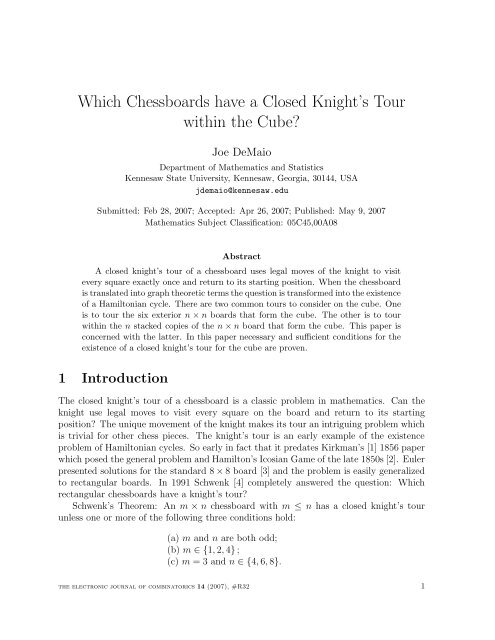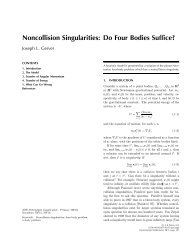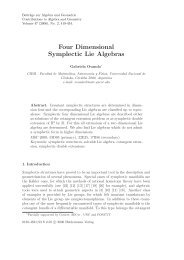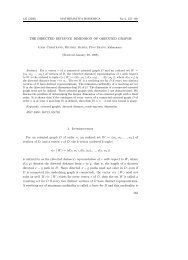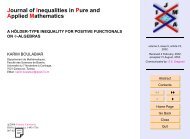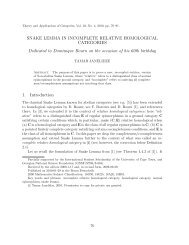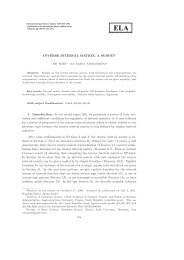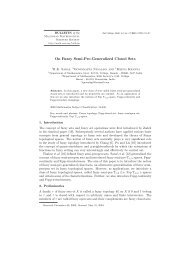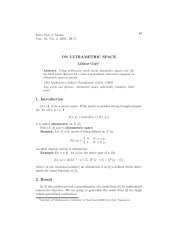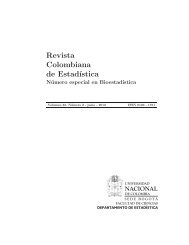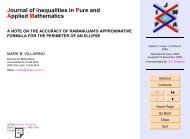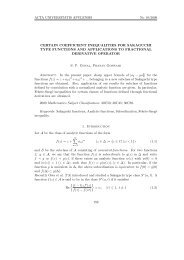Which Chessboards have a Closed Knight's Tour within the Cube?
Which Chessboards have a Closed Knight's Tour within the Cube?
Which Chessboards have a Closed Knight's Tour within the Cube?
Create successful ePaper yourself
Turn your PDF publications into a flip-book with our unique Google optimized e-Paper software.
<strong>Which</strong> <strong>Chessboards</strong> <strong>have</strong> a <strong>Closed</strong> Knight’s <strong>Tour</strong><br />
<strong>within</strong> <strong>the</strong> <strong>Cube</strong>?<br />
Joe DeMaio<br />
Department of Ma<strong>the</strong>matics and Statistics<br />
Kennesaw State University, Kennesaw, Georgia, 30144, USA<br />
jdemaio@kennesaw.edu<br />
Submitted: Feb 28, 2007; Accepted: Apr 26, 2007; Published: May 9, 2007<br />
Ma<strong>the</strong>matics Subject Classification: 05C45,00A08<br />
Abstract<br />
A closed knight’s tour of a chessboard uses legal moves of <strong>the</strong> knight to visit<br />
every square exactly once and return to its starting position. When <strong>the</strong> chessboard<br />
is translated into graph <strong>the</strong>oretic terms <strong>the</strong> question is transformed into <strong>the</strong> existence<br />
of a Hamiltonian cycle. There are two common tours to consider on <strong>the</strong> cube. One<br />
is to tour <strong>the</strong> six exterior n × n boards that form <strong>the</strong> cube. The o<strong>the</strong>r is to tour<br />
<strong>within</strong> <strong>the</strong> n stacked copies of <strong>the</strong> n × n board that form <strong>the</strong> cube. This paper is<br />
concerned with <strong>the</strong> latter. In this paper necessary and sufficient conditions for <strong>the</strong><br />
existence of a closed knight’s tour for <strong>the</strong> cube are proven.<br />
1 Introduction<br />
The closed knight’s tour of a chessboard is a classic problem in ma<strong>the</strong>matics. Can <strong>the</strong><br />
knight use legal moves to visit every square on <strong>the</strong> board and return to its starting<br />
position? The unique movement of <strong>the</strong> knight makes its tour an intriguing problem which<br />
is trivial for o<strong>the</strong>r chess pieces. The knight’s tour is an early example of <strong>the</strong> existence<br />
problem of Hamiltonian cycles. So early in fact that it predates Kirkman’s [1] 1856 paper<br />
which posed <strong>the</strong> general problem and Hamilton’s Icosian Game of <strong>the</strong> late 1850s [2]. Euler<br />
presented solutions for <strong>the</strong> standard 8 × 8 board [3] and <strong>the</strong> problem is easily generalized<br />
to rectangular boards. In 1991 Schwenk [4] completely answered <strong>the</strong> question: <strong>Which</strong><br />
rectangular chessboards <strong>have</strong> a knight’s tour?<br />
Schwenk’s Theorem: An m × n chessboard with m ≤ n has a closed knight’s tour<br />
unless one or more of <strong>the</strong> following three conditions hold:<br />
(a) m and n are both odd;<br />
(b) m ∈ {1, 2, 4} ;<br />
(c) m = 3 and n ∈ {4, 6, 8}.<br />
<strong>the</strong> electronic journal of combinatorics 14 (2007), #R32 1
The problem of <strong>the</strong> closed knight’s tour has been fur<strong>the</strong>r generalized to many threedimensional<br />
surfaces: <strong>the</strong> torus [5], <strong>the</strong> cylinder [6], <strong>the</strong> pillow [7], <strong>the</strong> Mobius strip, <strong>the</strong><br />
Klein bottle, <strong>the</strong> exterior of <strong>the</strong> cube [8], <strong>the</strong> interior levels of <strong>the</strong> cube, etc. Watkins provides<br />
excellent coverage of <strong>the</strong>se variations of <strong>the</strong> knight’s tour in Across <strong>the</strong> Board: The<br />
Ma<strong>the</strong>matics of Chessboard Problems [9]. However, <strong>the</strong> general analysis of <strong>the</strong>se threedimensional<br />
surfaces is to unfold <strong>the</strong>m into <strong>the</strong> two-dimensional plane, apply Schwenk’s<br />
Theorem as liberally as possible and tidy up any remaining cases as simply as possible.<br />
While this technique is successful at obtaining complete characterizations in some settings,<br />
it does not adequately tackle every surface and leaves <strong>the</strong> reader wondering what<br />
could be accomplished with a true three-dimensional technique.<br />
There are two common tours to consider on <strong>the</strong> cube. One is to tour <strong>the</strong> six exterior<br />
n × n boards <strong>the</strong> form <strong>the</strong> cube. Qing and Watkins [8] recently showed that a knight’s<br />
tour exists on <strong>the</strong> exterior of <strong>the</strong> cube for all n. The focus of this paper is <strong>the</strong> tour <strong>within</strong><br />
<strong>the</strong> n stacked copies of <strong>the</strong> n × n board that form <strong>the</strong> cube.<br />
In Watkins book three examples of closed knight’s tours <strong>within</strong> <strong>the</strong> three-dimensional<br />
chess board of <strong>the</strong> cube are provided. In two (<strong>the</strong> cubes of side 6 and 8) cases constructions<br />
take <strong>the</strong> closed knight’s tour for square boards and <strong>the</strong>n piece <strong>the</strong> boards back toge<strong>the</strong>r<br />
level by level to create a closed tour for <strong>the</strong> cube. Watkins does not provide a proof<br />
for <strong>the</strong> general case and indicates that <strong>the</strong> work lays in deciding which tours of <strong>the</strong> twodimensional<br />
board to use and where to make <strong>the</strong> jumps from level to level. He thanks<br />
Stewart [10] for having worked out <strong>the</strong> details for <strong>the</strong> cube of side 8. The technique of<br />
touring <strong>the</strong> cube level by level does not adopt itself well to a general proof since deciding<br />
which boards to use is one component of <strong>the</strong> construction.<br />
As a problem, Watkins assigns <strong>the</strong> exercise of constructing a closed knight’s tour for<br />
<strong>the</strong> cube of side 4. One possible solution is shown in Figure 1 [9]. Watkins notes that<br />
“since <strong>the</strong>re is not even an open tour of <strong>the</strong> 4 × 4 board ... this is perhaps a harder<br />
problem than finding a tour for <strong>the</strong> 8 × 8 × 8 chessboard.” I agree with Watkins. As seen<br />
with <strong>the</strong> closed tour of <strong>the</strong> cube of side 4, existence of a closed (or even open) tour of <strong>the</strong><br />
board is not a requirement for <strong>the</strong> existence of a tour for <strong>the</strong> cube of side n.<br />
4<br />
23<br />
30<br />
9<br />
27<br />
8<br />
13<br />
18<br />
36<br />
55<br />
62<br />
41<br />
59<br />
40<br />
45<br />
50<br />
29<br />
10<br />
3<br />
24<br />
14<br />
17<br />
28<br />
7<br />
61<br />
42<br />
35<br />
56<br />
46<br />
49<br />
60<br />
39<br />
22<br />
1<br />
12<br />
31<br />
5<br />
26<br />
19<br />
16<br />
54<br />
33<br />
44<br />
63<br />
37<br />
58<br />
51<br />
48<br />
11<br />
32<br />
21<br />
2<br />
20<br />
15<br />
6<br />
25<br />
43<br />
64<br />
53<br />
34<br />
52<br />
47<br />
38<br />
57<br />
1 2 3 4<br />
Figure 1: KT 1 , A <strong>Closed</strong> <strong>Tour</strong> of a <strong>Cube</strong> of Side 4<br />
Kumar [11] notes that “little attention has been paid” to <strong>the</strong> knight’s tour extension<br />
“in three-dimensional space.” Kumar has constructed and investigated many closed and<br />
open knight’s tours for parameters ≤ 8 but does not tackle <strong>the</strong> general case.<br />
<strong>the</strong> electronic journal of combinatorics 14 (2007), #R32 2
As it turns out <strong>the</strong> characterization of cubes that admit a closed knight’s tour is very<br />
easy to state. Fur<strong>the</strong>rmore, once you divest yourself of <strong>the</strong> notion of tackling <strong>the</strong> cube by<br />
its two-dimensional levels, <strong>the</strong> proof falls out in a very natural inductive manner.<br />
Theorem: For n ≥ 4, <strong>the</strong> cube of side n contains a closed knight’s tour if and only if<br />
n is even.<br />
First of all, note that <strong>the</strong> cubes of sides n = 1, 2, 3 are too small to allow a knight to<br />
move from every square. For n = 1, 2 <strong>the</strong> knight cannot make a legal move. For n = 3,<br />
<strong>the</strong> knight cannot move to or from <strong>the</strong> center cell.<br />
2 The nonexistence of a closed knight’s tour <strong>within</strong><br />
<strong>the</strong> cube of side n ≡ 1 mod 2<br />
There exists no closed knight’s tour <strong>within</strong> <strong>the</strong> cube of side n where n is odd. This is a<br />
clear analogue of <strong>the</strong> fact that a closed knight’s tour does not exist on <strong>the</strong> n × m board<br />
where both n and m are odd. It is not quite as immediate for <strong>the</strong> cube. Especially so as<br />
one considers <strong>the</strong> extra freedom granted in <strong>the</strong> cube as <strong>the</strong> knight extends its reach from<br />
8 moves to 24 moves. For boards on an odd numbered level start with a black square<br />
in <strong>the</strong> upper left hand corner. For those boards on an even numbered level, start with a<br />
white square in <strong>the</strong> upper left hand corner. Now all legal moves of <strong>the</strong> knight alternate<br />
colors as demonstrated in Figure 2 with <strong>the</strong> a − b, c − d and e − f moves. The resulting<br />
graph of legal moves of <strong>the</strong> knight on <strong>the</strong> cube is now bipartite. When considering <strong>the</strong><br />
cube as a whole, this coloring scheme seems very natural as all adjacent squares alternate<br />
color.<br />
a<br />
e<br />
f<br />
b<br />
c<br />
d<br />
1 2 3 4<br />
Figure 2<br />
For <strong>the</strong> cube of side n <strong>the</strong>re will exist ⌈ ⌉ ⌊ ⌋<br />
n 3<br />
2 black squares and n 3<br />
2 white squares.<br />
If n is odd <strong>the</strong>n ⌈ ⌉ ⌊ ⌋<br />
n 3<br />
2 ≠ n 3<br />
2 and <strong>the</strong> corresponding bipartite graph will not contain a<br />
Hamiltonian cycle. Note that this argument easily extends to show that <strong>the</strong> n × m × k<br />
board does not admit a closed knight’s tour where n, m and k are all odd.<br />
<strong>the</strong> electronic journal of combinatorics 14 (2007), #R32 3
3 Construction of a closed knight’s tour <strong>within</strong> <strong>the</strong><br />
cube of side n ≡ 0 mod 4<br />
For n = 4k, take k copies of KT 1 of Figure 1 placed left to right. Any two copies of KT 1<br />
can be combined to create a closed tour on <strong>the</strong> 4 × 8 × 4 board by deleting <strong>the</strong> 2 − 3 edge<br />
on level 1 of <strong>the</strong> left KT 1 and <strong>the</strong> 14 − 15 edge on level 2 of <strong>the</strong> right KT 1 . Next create<br />
<strong>the</strong> 2 − 15 and 3 − 14 edges as shown in Figure 3. Repeat this process left to right for <strong>the</strong><br />
remaining copies of KT 1 and <strong>the</strong> result is a closed knight’s tour for <strong>the</strong> 4 × n × 4 board<br />
which we shall denote KT 2 .<br />
27<br />
8<br />
13<br />
18<br />
4<br />
23<br />
30<br />
9<br />
14<br />
17<br />
28<br />
7<br />
29<br />
10<br />
3<br />
24<br />
5<br />
26<br />
19<br />
16<br />
22<br />
1<br />
12<br />
31<br />
20<br />
15<br />
6<br />
25<br />
11<br />
32<br />
21<br />
2<br />
Figure 3<br />
Now create k − 1 additional copies of KT 2 placed below each o<strong>the</strong>r. On level 2 in <strong>the</strong><br />
leftmost KT 1 of each KT 2 , delete <strong>the</strong> 5 − 6 edge on <strong>the</strong> back copy of KT 2 and <strong>the</strong> 7 − 8<br />
edge on <strong>the</strong> front copy of KT 2 and create <strong>the</strong> 5 − 8 and 6 − 7 edges as shown in Figure<br />
4. This creates a closed knight’s tour for <strong>the</strong> n × n × 4 board, denoted KT 3 .<br />
27<br />
8<br />
13<br />
18<br />
14<br />
17<br />
28<br />
7<br />
5<br />
26<br />
19<br />
16<br />
20<br />
15<br />
6<br />
25<br />
27<br />
8<br />
13<br />
18<br />
14<br />
17<br />
28<br />
7<br />
5<br />
26<br />
19<br />
16<br />
20<br />
15<br />
6<br />
25<br />
Figure 4<br />
Finally take k − 1 copies of KT 3 and stack <strong>the</strong>m atop one ano<strong>the</strong>r. To connect two<br />
copies of KT 3 delete <strong>the</strong> 46 − 47 edge of level 4 in <strong>the</strong> leftmost KT 1 in <strong>the</strong> bottom copy<br />
and <strong>the</strong> 10 − 11 edge of level 1 in <strong>the</strong> top copy of KT 3 in <strong>the</strong> leftmost KT 1 . Now create<br />
<strong>the</strong> 10 − 47 and 11 − 46 edges. This results in a closed knight’s tour for <strong>the</strong> cube of side<br />
n = 4k for all positive integers k. Of course this method can be used to construct a<br />
closed knight’s tour for <strong>the</strong> n × m × k board for n, m, k ≡ 0 mod 4.<br />
<strong>the</strong> electronic journal of combinatorics 14 (2007), #R32 4
4 Construction of a closed knight’s tour <strong>within</strong> <strong>the</strong><br />
cube of side n ≡ 2 mod 4<br />
First a base case of a closed knight’s tour of side n = 6 is provided from [11].<br />
47<br />
50<br />
53<br />
38<br />
41<br />
62<br />
104<br />
81<br />
102<br />
85<br />
88<br />
83<br />
5<br />
16<br />
7<br />
34<br />
3<br />
36<br />
52<br />
39<br />
48<br />
63<br />
54<br />
37<br />
101<br />
94<br />
105<br />
82<br />
75<br />
86<br />
18<br />
33<br />
4<br />
1<br />
8<br />
27<br />
49<br />
46<br />
51<br />
40<br />
61<br />
42<br />
80<br />
103<br />
100<br />
87<br />
84<br />
89<br />
15<br />
6<br />
17<br />
28<br />
35<br />
2<br />
66<br />
69<br />
64<br />
57<br />
72<br />
55<br />
95<br />
106<br />
93<br />
76<br />
99<br />
74<br />
22<br />
19<br />
32<br />
11<br />
26<br />
9<br />
45<br />
58<br />
67<br />
70<br />
43<br />
60<br />
92<br />
79<br />
108<br />
97<br />
90<br />
77<br />
31<br />
14<br />
21<br />
24<br />
29<br />
12<br />
68<br />
65<br />
44<br />
59<br />
56<br />
71<br />
107<br />
96<br />
91<br />
78<br />
73<br />
98<br />
20<br />
23<br />
30<br />
13<br />
10<br />
25<br />
1 2 3<br />
122<br />
133<br />
138<br />
115<br />
120<br />
131<br />
185<br />
204<br />
193<br />
216<br />
187<br />
206<br />
174<br />
165<br />
176<br />
147<br />
150<br />
163<br />
137<br />
114<br />
121<br />
132<br />
139<br />
116<br />
194<br />
199<br />
186<br />
205<br />
192<br />
215<br />
177<br />
146<br />
173<br />
164<br />
167<br />
148<br />
134<br />
123<br />
136<br />
117<br />
130<br />
119<br />
203<br />
184<br />
211<br />
198<br />
207<br />
188<br />
172<br />
175<br />
166<br />
149<br />
162<br />
151<br />
113<br />
144<br />
111<br />
124<br />
127<br />
140<br />
200<br />
195<br />
202<br />
189<br />
214<br />
191<br />
145<br />
178<br />
155<br />
170<br />
159<br />
168<br />
110<br />
135<br />
142<br />
129<br />
118<br />
125<br />
183<br />
210<br />
197<br />
212<br />
181<br />
208<br />
154<br />
171<br />
180<br />
157<br />
152<br />
161<br />
143<br />
112<br />
109<br />
126<br />
141<br />
128<br />
196<br />
201<br />
182<br />
209<br />
190<br />
213<br />
179<br />
156<br />
153<br />
160<br />
169<br />
158<br />
4 5 6<br />
Figure 5: A <strong>Closed</strong> <strong>Tour</strong> of a <strong>Cube</strong> of Side 6<br />
Extending this cube of side 6 to a cube of side n ≡ 2 mod 4 will not be as simple<br />
as extending <strong>the</strong> cube of side 4 to a cube of side n ≡ 0 mod 4. We cannot just take<br />
copies of <strong>the</strong> cube of side 6 to use as an extension since <strong>the</strong> formal induction employed<br />
is to show that <strong>the</strong> existence of a tour <strong>within</strong> <strong>the</strong> cube of side n ≡ 2 mod 4 implies <strong>the</strong><br />
existence of a tour <strong>within</strong> <strong>the</strong> cube of side n + 4. O<strong>the</strong>r closed tours of rectangular prisms<br />
will be required.<br />
Consider <strong>the</strong> closed tour on <strong>the</strong> 3 × 6 × 4 board of Figure 6. Take two copies of Figure<br />
6 placed front to back. Now, delete <strong>the</strong> 37 − 38 edge on level 1 in <strong>the</strong> front copy and <strong>the</strong><br />
8 − 9 edge on level 2 in <strong>the</strong> back copy. Using those same vertices, create <strong>the</strong> 8 − 38 edge<br />
and <strong>the</strong> 9 − 37 edge. This provides us with a closed knight’s tour for <strong>the</strong> 6 × 6 × 4 board.<br />
<strong>the</strong> electronic journal of combinatorics 14 (2007), #R32 5
1<br />
6<br />
47<br />
28<br />
33<br />
38<br />
52<br />
49<br />
72<br />
7<br />
40<br />
27<br />
46<br />
57<br />
4<br />
37<br />
12<br />
31<br />
71<br />
64<br />
53<br />
26<br />
19<br />
8<br />
5<br />
2<br />
43<br />
32<br />
29<br />
34<br />
54<br />
51<br />
48<br />
9<br />
42<br />
39<br />
1 2<br />
55<br />
58<br />
67<br />
10<br />
13<br />
22<br />
66<br />
63<br />
60<br />
21<br />
18<br />
15<br />
68<br />
3<br />
44<br />
23<br />
30<br />
35<br />
61<br />
50<br />
69<br />
16<br />
41<br />
24<br />
45<br />
56<br />
59<br />
36<br />
11<br />
14<br />
70<br />
65<br />
62<br />
25<br />
20<br />
17<br />
3 4<br />
Figure 6: A <strong>Closed</strong> <strong>Tour</strong> of <strong>the</strong> 3 × 6 × 4 Board<br />
The first step in constructing a closed knight’s tour for <strong>the</strong> cube of side n = 4k + 2 is<br />
to stack k − 1 copies of <strong>the</strong> 6 × 6 × 4 board on top of <strong>the</strong> cube of side 6 of Figure 5. Delete<br />
<strong>the</strong> 174 − 175 edge of Figure 5 and <strong>the</strong> 5 − 6 edge of <strong>the</strong> back copy of <strong>the</strong> 6 × 6 × 4 board.<br />
Create <strong>the</strong> 5 − 174 and 6 − 175 edges to form a closed knight’s tour on <strong>the</strong> 6 × 6 × 10<br />
board. Attach <strong>the</strong> remaining k − 2 Figure 6s by deleting in adjacent pairs (front or back,<br />
but matching) of <strong>the</strong> 6 × 6 × 4 board, <strong>the</strong> 65 − 66 edge of level 4 of <strong>the</strong> bottom Figure 6<br />
and <strong>the</strong> 5 − 6 edge of level 1 of <strong>the</strong> top Figure 6 and creating 5 − 66 and 6 − 65 edges,<br />
thus creating <strong>the</strong> closed tour for <strong>the</strong> 6 × 6 × n box.<br />
The second step is to extend this construction to width n. Consider <strong>the</strong> open tour of<br />
Figure 7. Note that k copies of this open tour can be extended to an open 6 × 4k tour by<br />
deleting <strong>the</strong> 22 − 23 edge and creating <strong>the</strong> 1 − 22 and 23 − 24 edges in adjacent copies.<br />
1<br />
4<br />
23<br />
20<br />
1<br />
4<br />
23<br />
20<br />
1<br />
4<br />
23<br />
20<br />
24<br />
21<br />
2<br />
5<br />
24<br />
21<br />
2<br />
5<br />
24<br />
21<br />
2<br />
5<br />
3<br />
6<br />
19<br />
22<br />
3<br />
6<br />
19<br />
22<br />
3<br />
6<br />
19<br />
22<br />
16<br />
13<br />
8<br />
11<br />
16<br />
13<br />
8<br />
11<br />
16<br />
13<br />
8<br />
11<br />
7<br />
10<br />
15<br />
18<br />
7<br />
10<br />
15<br />
18<br />
7<br />
10<br />
15<br />
18<br />
14<br />
17<br />
12<br />
9<br />
14<br />
17<br />
12<br />
9<br />
14<br />
17<br />
12<br />
9<br />
Figure 7: An Open <strong>Tour</strong> of <strong>the</strong> 6 × 4 Board and Extension<br />
Create six copies of a 6 × (n − 6) open tour as indicated in Figure 7. In <strong>the</strong> base cube<br />
of side 6 from Figure 5, delete <strong>the</strong> 41 − 42, 88 − 89, 2 − 3, 119 − 120, 187 − 188 and<br />
150 − 151 edges on levels 1 though 6 and <strong>the</strong>n using one copy of <strong>the</strong> 6 × (n − 6) open<br />
tour per level create <strong>the</strong> 1 − 42, 24 − 41, 1 − 89, 24 − 88, 1 − 2, 3 − 24, 1 − 119, 24 − 120,<br />
1 − 188, 24 − 187, 1 − 151 and 24 − 150 edges. Next create an additional n − 6 copies<br />
of a 6 × (n − 6) open tour of Figure 7. These copies will be attached to <strong>the</strong> n − 6 copies<br />
of Figure 6 that were stacked on top of <strong>the</strong> base cube of side 6 from Figure 5. To do so<br />
delete <strong>the</strong> 33 − 34, 39 − 40, 13 − 14 and 17 − 18 edges on levels 1 through 4. Take four<br />
<strong>the</strong> electronic journal of combinatorics 14 (2007), #R32 6
copies of a 6 × (n − 6) open tour of Figure 7 per Figure 6, delete <strong>the</strong> 33 − 34, 39 − 40,<br />
13 − 14 and 17 − 18 edges and create <strong>the</strong> 1 − 34, 24 − 33, 1 − 39, 24 − 40, 1 − 14, 13 − 24,<br />
1 − 17 and 18 − 24 edges.<br />
This now forms a closed knight’s tour for <strong>the</strong> 6 × n × n rectangular prism. This tour<br />
will form <strong>the</strong> back wall of <strong>the</strong> cube of side n ≡ 2 mod 4. Now we play this game again to<br />
create <strong>the</strong> left wall of <strong>the</strong> cube of side n ≡ 2 mod 4 as shown in Figure 8. Once <strong>the</strong> left<br />
wall is completed, a cube of side n−6 ≡ 0 mod 4 and a board of size (n − 6)×(n − 6)×6<br />
will be inserted to complete <strong>the</strong> cube of side n ≡ 2 mod 4.<br />
6 n-6<br />
6<br />
n<br />
n-6<br />
(n-6) x ( n-6) x 6<br />
(n-6) x ( n-6) x ( n-6)<br />
Figure 8: Construction of a <strong>Cube</strong> of Side n ≡ 2 mod 4<br />
Once again, create six copies of a 6 × (n − 6) open tour as indicated in Figure 7. In<br />
<strong>the</strong> base cube of side 6 from Figure 5, delete <strong>the</strong> 59 − 60, 77 − 78, 12 − 13, 125 − 126,<br />
208 − 209 and 160 − 161 edges on levels 1 through 6. Next create <strong>the</strong> 1 − 59, 24 − 60,<br />
1 − 78, 24 − 77, 1 − 13, 12 − 24, 1 − 126, 24 − 125, 1 − 209, 24 − 208, 1 − 160 and 24 − 161<br />
edges. Take four copies of a 6 × (n − 6) open tour as indicated in Figure 7 per board,<br />
delete <strong>the</strong> 31 − 32, 8 − 9, 35 − 36 and 24 − 25 edges in each copy of <strong>the</strong> 6 × 6 × 4 board of<br />
Figure 6 and create <strong>the</strong> 1 − 32, 24 − 31, 1 − 9, 8 − 24, 1 − 36, 24 − 35, 1 − 25 and 24 − 24<br />
edges.<br />
This construction yields <strong>the</strong> left and back walls of our cube of length, height and<br />
width n, going in 6 squares. Now use a cube of side n − 6. Since n ≡ 2 mod 4 <strong>the</strong>n<br />
n − 6 ≡ 0 mod 4 and we can take a cube from our previous construction. Take this cube<br />
and note <strong>the</strong> 3 − 4 edge on level 1 in <strong>the</strong> very first KT 1 . Fur<strong>the</strong>rmore note <strong>the</strong> 9 − 10<br />
edge in <strong>the</strong> open 6 × 4 tour of Figure 7. Delete <strong>the</strong>se two edges and create <strong>the</strong> 3 − 9 and<br />
4 − 10 edges. All that is left is to extend this cube up 6 squares. To do so construct a<br />
closed tour of <strong>the</strong> (n − 6) × (n − 6) × 2 board.<br />
<strong>the</strong> electronic journal of combinatorics 14 (2007), #R32 7
1 14 23 28<br />
24 27 2 13<br />
15 4 25 22<br />
26 21 16 3<br />
10 5 32 19<br />
31 20 9 6<br />
8 11 18 29<br />
17 30 7 12<br />
1 2<br />
Figure 9: A <strong>Closed</strong> <strong>Tour</strong> of <strong>the</strong> 4 × 4 × 2 Board<br />
Take Figure 9 and extend it widthwise by creating multiple copies. Delete <strong>the</strong> 2 − 3<br />
edge on level 1 of <strong>the</strong> left copy and <strong>the</strong> 30−31 edge of level 2 of <strong>the</strong> right copy. Create <strong>the</strong><br />
2 − 31 and 3 − 30 edges. Now take multiple copies of this new construction and extend it<br />
lengthwise by deleting on level 1 on <strong>the</strong> leftmost side of <strong>the</strong> back copy <strong>the</strong> 21 − 22 edge<br />
and on level 1 on <strong>the</strong> leftmost side of <strong>the</strong> front copy <strong>the</strong> 23 − 24 edge. Now create <strong>the</strong><br />
21 − 24 and 22 − 23 edges. Finally stack 3 copies of this new construction by deleting in<br />
adjacent copies <strong>the</strong> 10 − 11 edge on level 2 of <strong>the</strong> bottom copy and <strong>the</strong> 14 − 15 edge on<br />
level 1 of <strong>the</strong> top copy and creating <strong>the</strong> 10 − 15 and 11 − 14 edges. Attach this closed<br />
tour to <strong>the</strong> cube of side n − 6 by deleting any 15 − 16 edge of level 1 of this construction.<br />
Note that this level 1 is sitting atop a level 4 of a KT 1 in <strong>the</strong> construction of <strong>the</strong> cube of<br />
side n − 6. Delete <strong>the</strong> 51 − 52 edge in this KT 1 and create <strong>the</strong> 15 − 51 and 16 − 52 edges,<br />
thus creating <strong>the</strong> closed knight’s tour on <strong>the</strong> cube of side n ≡ 2 mod 4.<br />
5 Future Work<br />
The next step in this work is to extend this characterization of <strong>the</strong> cubes which admit a<br />
closed knight’s tour to a characterization of <strong>the</strong> general rectangular prism. My conjecture<br />
is that like <strong>the</strong> cube, once <strong>the</strong> dimensions of <strong>the</strong> rectangular prism grow to be sufficiently<br />
large only <strong>the</strong> prism with an odd number of squares will not admit a closed knight’s tour.<br />
REFERENCES<br />
[1] T. P. Kirkman, On <strong>the</strong> Representation of Polyhedra, Philosophical Transactions of <strong>the</strong><br />
Royal Society (London) 146 (1856), 413-418<br />
[2] J. L. Gross, J. Yellen ed., Handbook of Graph Theory, CRC Press, Boca Raton, 2004<br />
[3] L. Euler, Solutio d’une Question Curieuse qui ne Peroit Soumise a Aucune Analyse,<br />
Mem. Acad. Sci. Berlin 15 (1759), 310-337<br />
[4] A. J. Schwenk, <strong>Which</strong> Rectangular <strong>Chessboards</strong> <strong>have</strong> a Knight’s <strong>Tour</strong>? Ma<strong>the</strong>matics<br />
Magazine 64:5 (December 1991) 325-332.<br />
[5] J. J. Watkins, Knight’s <strong>Tour</strong>s on a Torus. Ma<strong>the</strong>matics Magazine 70(3) (1997), 175-184<br />
[6] J. J. Watkins, Knight’s <strong>Tour</strong>s on Cylinders and o<strong>the</strong>r surfaces. Congressus Nunerantium<br />
143, (2000) 117-127.<br />
[7] G. Cairns, Pillow Chess. Ma<strong>the</strong>matics Magazine, Vol. 75, No. 3. (June, 2002), 173-186<br />
<strong>the</strong> electronic journal of combinatorics 14 (2007), #R32 8
[8] Y. Qing and J.J. Watkins, Knight’s <strong>Tour</strong>s for <strong>Cube</strong>s and Boxes, Congressus Numerantium<br />
181 (2006) 41-48<br />
[9] J. J. Watkins, Across <strong>the</strong> Board: The Ma<strong>the</strong>matics of Chessboard Problems, Princeton<br />
University Press, Princeton, 2004.<br />
[10] I. Stewart, 1971 Solid Knight’s <strong>Tour</strong>s. Journal of Recreational Ma<strong>the</strong>matics Vol 4(1),<br />
January 1971.<br />
[11] A. Kumar, Studies in <strong>Tour</strong>s of <strong>the</strong> Knight in Three Dimensions, The Games and<br />
Puzzles Journal — Issue 43, http://www.gpj.connectfree.co.uk/gpj43.htm<br />
<strong>the</strong> electronic journal of combinatorics 14 (2007), #R32 9


